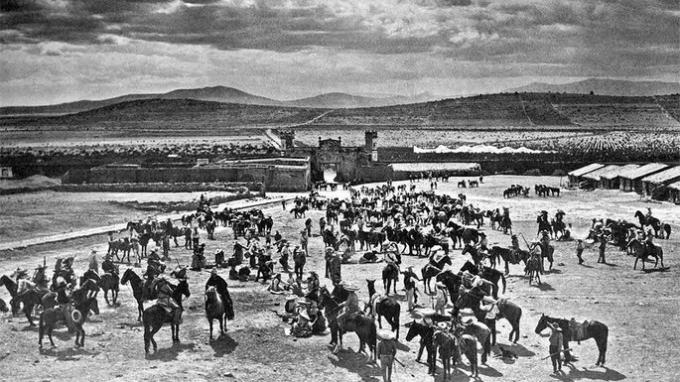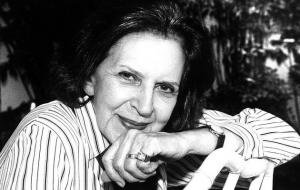Pedro Páramo by Juan Rulfo: summary, characters and analysis of the Mexican novel
Pedro Paramo is a novel written by the Mexican Juan Rulfo in 1955, which has become a classic of literature. It is framed in a universal literary topic: the son who seeks his father to claim his place. It also embodies a reality of the twentieth century Latin American world: the role of caciquismo and violence in the social conformation.
Both aspects are not excluded but rather implied, summarizing the construction of a patriarchal imaginary. But what interpretation can we give to this work? Where does its importance lie? What makes it a work of universal value?
Summary of Pedro Paramo

The story begins when Juan Preciado decides to go in search of his father, Pedro Páramo, in the town of Comala. This trip represented the fulfillment of the promise made to his mother, Dolores Preciado, on her deathbed.
Juan Preciado in Comala
When Juan Preciado arrives in Comala, he discovers that his father is dead and, along with him, has died practically the entire town, evidence that there is nothing left of the vivacious Comala that his mother so much longed for.
He is received first by the spirit of Abundio, who leads him to the spirits of Eduviges Dyada and Damiana Cisneros. Through the stories of the deceased, Juan reconstructs the story of his father.
Pedro Páramo falls in love with Susana
Pedro Páramo was the son of Lucas Páramo. Since he was a child he had fallen in love with Susana, daughter of Bartolomé San Juan. However, Susana married Florencio and, when he died, she began to lose her lucidity. None of this mattered to Pedro, but to have Susana, to which Don Bartolomé firmly opposed.
After the conquest of power and Susana
Upon the death of Pedro's father, the young man inherited the Media Luna estate. Since then, he has devoted his entire life to seizing power in Comala, using fraud, assassinations, rapes and blackmail. His hidden motivation was to get Susana back.
In order to make his fortune, Pedro married Dolores Preciado in communion of property, whose properties he seized. As soon as Dolores saw that Pedro Páramo was turning into a tyrant, she abandoned him forever along with her son, Juan Preciado.
Consolidation of the power of Pedro Páramo
Pedro Páramo recognized and took care of his illegitimate son Miguel Páramo, a corrupt young man, murderer and rapist, who died on horseback after jumping over a boundary that his father had raised. Pedro Páramo bribed Father Renteria to give him absolution, knowing that the priest's family had been the target of Miguel's crimes.
Assassination of Bartolomé San Juan
In view of the fact that the treasured power did not intimidate Bartolomé San Juan, Pedro Páramo decided to have him killed, without realizing that it was precipitating Susana's final madness. Pedro took her to Media Luna and devotedly cared for her ever since, but he was never able to crystallize her love.
The revolution in Comala
When the revolutionaries arrive in town, the chief determines that the best way to survive is to collaborate with them. He offers them more money than they ask for and puts three hundred men at his disposal.
Susana's death
Meanwhile, Susana's health was deteriorating. On the day of her death, the people held a great feast, instead of mourning the loss that afflicted the provider of all her goods. Outraged, Pedro Páramo decided to take revenge on the town, "folding his arms" until Comala died of abandonment and hunger along with his patriarch.
The death of Pedro Páramo
Although it seems that Pedro Páramo is stabbed to death by Abundio Martínez, a closer reading allows us to understand that Pedro Páramo dies old, alone and undone, like falling stones.
The death of Juan Preciado
After this mysterious experience, Juan is hosted by the still alive Donis and Dorotea, subjected by him to an incestuous relationship. The murmurs of the penitent souls of Comala overwhelm Juan Preciado in such a way that he dies of terror in the middle of the street. When Dorotea dies, both are buried in the same grave, from where Juan tells his story.
Main characters

Juan Preciado: protagonist. He heads to Comala in search of his father.
Dolores Preciado: first wife of Pedro Páramo and mother of Juan Preciado. She expects her son to collect from her father for the property she stole from him.
Pedro Paramo: Cacique de Comala, owner of the Media Luna hacienda and almost the entire town. His purpose is to conquer the love of Susana San Juan.
Lucas Paramo: father of Pedro Páramo. She thinks of her son as lazy.
Miguel Paramo: illegitimate but recognized son of Pedro Páramo. She has criminal behaviors.
Susana San Juan: childhood friend and second wife of Pedro Páramo. She begins to lose her mind with the death of her first husband and then her father.
Bartolomé San Juan: father of Susana San Juan.
Justina Diez: Susana San Juan's caretaker during her stay at the Media Luna ranch.
Fulgor Sedano: foreman of the Media Luna farm. Ally of Pedro Páramo. He dies assassinated by the revolutionaries.
Gerardo Trujillo: Pedro Páramo's lawyer. He hopes to get financial compensation from him for all the cover-ups of the past.
Abundio Martínez: muleteer, illegitimate and unrecognized son of Pedro Páramo.
Refuge: wife of Abundio Martínez.
Eduviges Dyada: Comala's host, former friend of Dolores Preciado. Receive Juan Preciado.
Damiana Cisneros: Cook at the Media Luna hacienda.
Father Renteria: Parish priest of Comala who allows himself to be manipulated and used by the rich and powerful, especially Pedro Páramo.
Ana Renteria: niece of Father Renteria. She was the victim of a rape perpetrated by Miguel Páramo.
Donis: inhabitant of Comala who lives with Dorotea, and keeps her captive in her own house.
Dorotea: Donis's wife. Responsible for getting women to the criminal Miguel Páramo.
Stutterer: messenger who informs Pedro Páramo about the murder of Fulgor Sedano.
Revolutionaries: peasants revolted against the political and economic order. Perseverancio and Casildo stand out.
Damasio, the Tilcuate: Pedro Páramo's assistant, infiltrated among the revolutionaries to control them.
Other characters: Matilde Preciado, Florencio, Inés Villapandio, Gamaliel Villalpandio, Micaela, Rogelio, the Colorado horse, Inocente Osorio, Toribio Aldrete, Terencio Lubianes, Ubillado, Isaías, Jesús, Margarita, María Dyada, Sixtina Cisneros, Filoteo Aréchiga, Galileo, Chona, Filomeno, Melquíades, Juliana, Sóstenes, Prudencio, Dona Ángeles, Dona Fausta and the Indians.
It may interest you: 25 short novels to read in one day.
Analysis of Pedro Páramo

Pedro Páramo's story is not simple. Multiple voices intertwine in a universe where it seems that the actions are superimposed on each other in a circular and mythical time.
According to Alberto Vital in a text entitled Pedro Paramo, this novel manages to synthesize two currents that were looking for a place in Mexican literature of the early twentieth century. On the one hand, the nationalist current, anchored in the imaginary of the countryside and / or the revolution. On the other, the universalist, eager for literary experimentation.
Therefore, Rulfo captures two transformation processes: an aesthetic one as far as literature is concerned; and another sociocultural in terms of the narrated story, which transcends any ideological bias.
Narrative structure and style of the novel Pedro Paramo
Vital also notes that the work presents two main lines of action: one focused on the fate of Juan Preciado and the other on the fate of Pedro Páramo. But how are they exposed in the text?
Pedro Paramo it is structured in sixty-nine passages that are interspersed without following a chronological order. Each fragment is a different narrative thread in the voice of different characters. Temporal overlays, jumps, and ellipsis are images of phantasmagoric echoes that, like the flow of thought, pass through each other in no apparent order.
The first of these voices is that of Juan Preciado, who tells the motivation and story of his trip to Comala, although we do not know the time of his enunciation. Juan Preciado's story gives way to other narrative voices.
We do not know if these voices could only be silenced with the death of the last of Pedro Páramo's descendants. What we do know is that Juan Rulfo makes these spectral voices, belonging to the world of dead, coexist with the world of the living with the greatest naturalness, which introduces us to the of magical realism.
It may interest you: Magic realism: characteristics, authors and works.
Language and popular expressions
The writer is anchored in the twists of popular language and the Mexican cultural horizon and, why not, Latin American. But his narrative style gives him such significant force that he manages to give this world universality.
The researcher María Luisa Bastos states that the center of each episode develops from phrases taken from the literary tradition or from the language itself.
Thus, Juan Rulfo turns to popular language and develops narrative nuclei based on various figurative routes. Bastos exposes some topics built from popular turns of language: «" go very far "and its variants; "the thread of life" and its variants; "The Golden Age"; "the primordial Eden" ».
Regarding the phrase “go very far” and his versions, Bastos points out the actions of Pedro Páramo and his children. For example, Miguel is a criminal with overwhelming appetites, who dies when he literally exceeds the limits imposed by his father; while Juan Preciado dies in the pretense of "going far" to claim the place of his father.
For María Luisa Bastos, the phrase and the principle "the thread of life" is also expressed in other variants such as "the light" or "the flame", and embodies various fundamental meanings in the text. Sometimes, it is the weak light that guides the characters; others, dire omens.
The golden age and that primordial Eden are represented in the world of illusions and self-absorption of the characters, especially Dolores and Susana, although we can say that also from Pedro. The first, yearning for a springtime and lively Comala, unable to notice or conceive of her new directions.
The second, Susana, lives in the delusions of her past. But also, she is herself the illusion of Pedro Páramo, who remembers her childhood with her as a primordial and mythical time to which he longs to return. In the words of Bastos, “Susana has been the secret axis of the life of the Pedro Páramo man”, and she is, in fact, the main motive for his actions.
Chieftaincy and tyranny
The story of Pedro Páramo is for us the metaphorical image of the universal dilemma of the patriarchal order. At the same time, it is the historicized image of a people traversed by caciquismo, authoritarianism, violence, arbitrariness, complicity with power and superstition, and that he is condemned to his destruction.
The character of Pedro Páramo is the archetype of the tyrant who concentrates the power and the means to control the collective destiny at his service. He even tries to control the order of the afterlife, that is, of the other world, through his intimidating relationships with the Church.
But the chief is also a man and no more than a disgraced man, whose power is useless to achieve transcendence. He does not achieve it through Susana's love or through her collective memory. His raw violence erases Comala and, with Comala, Pedro Páramo is erased.
Transcendence and oblivion
Pedro's autarky is, in a way, an autophagic order, destined to eat himself up. Pedro Páramo consumes everything in his path even after he dies.
Pedro is a parent and a provider, but he is not a parent in the endearing sense of the term. His children cannot, therefore, be children or brothers. They are specters, shadows of his father, who compete with him (Miguel), who resent him (Abundio), who charge him (Juan).
Like a Saturn that devours his children, Juan Preciado is devoured by the universe of his father, which is the denial of all humanity, all freedom, all transcendence. Like the archetypal Sarah of the Old Testament, John loses himself when he turns to see a barren past with nothing to offer.
The revolution as precipitation of the end
Maybe the novel Pedro Paramo represent the symbolic death of the filicidal order that sacrifices children for authoritarianism to dominate.
After all, the revolution that is advancing on Comala does not have the strength to transform things either, just to accelerate their destruction. He doesn't have it because he lacks substance.
"As you can see, we have risen in arms." "So?" Is that not enough? ”“ But why have they done it? ”“ Because others have done it too. Don't you know? Wait a while for instructions and then we will find out the cause. For now we are here.
Pedro Paramoby Juan Rulfo
In Rulfo's representation, the revolution is not unified or has a clear meaning, but responds to diverse interests. The revolution is a new expression, a collective expression of a violent and arbitrary order. In the eyes of Pedro's character, the revolution lacks any historical significance and is hardly recognized as an opportunity for looting and power.
The meaning of Pedro Páramo
Blas Matamoro, in an essay entitled Father's name, alludes to the meaning of the name Pedro Páramo. On the one hand, Pedro means stone; on the other, the páramo is a place of extreme temperatures and, therefore, desert. The name is already the harbinger of what the reader will find.
To this equation, Matamoro adds three fundamental elements, namely:
- The hero begins a journey in search of his father, yearning to take his place, a topic of universal literature;
- However, contrary to the classical paradigm, the hero does so by maternal mandate;
- The mother imposes as a condition that she wait for her death.
These three elements come together naturally within the framework of culture such as that of Latin America, where the patriarchal order and matricentrality coexist in tension.
Pedro Páramo, this stone of the desert, is the absent, incorporeal, spectral father. For this reason, the destiny sought by Juan Preciado cannot be the vindication. Juan's journey is, for Blas Matamoro, a descent into hell. The author says «... the hero goes to hell to look for his father, because his father is there, dead. To arrive at the place of the father is to arrive at the realm of death. To meet the father is to die, to stay and live with the dead.
Hence the importance of symbolic imagination, expressed in mythical language. For example, for Matamoro this language is reflected even in places such as Comala, Contla, La Media Luna and Los Confines.
The author says that Comala is on the outer edge of life. Contla, as if it were Atlantis, it is a land that everyone seeks but no one finds. La Media Luna witnesses the gait of the deceased's horse and, finally, Los Confines is where the father would be found.
Another thing, even more transcendent, points out Blas Matamoro than Pedro Páramo: "It is the wasteland of death, but the firm rock where the building of order, built according to the law, sits.
Then, Pedro Páramo acts as a giver of life, as a provider, as a sender of death, as a legislator, as a judge, as an avenger, as a punisher, as a disembodied being, as a commander of armies, in short, as a god. Thus the mythical order of the character and the story is affirmed.
Rulfo collects the universe of beliefs, symbolic imagination and traditions typical of Latin American culture, which not even death can silence. They live, are concomitant, and are what give meaning and transcendence to the web of lives undone of Pedro Paramo.
References
Bastos, María Luisa: Topics and narrative nuclei in Pedro Páramo. Hispano-American Notebooks. No. 421-423, July-September 1985.
Matamoro, Blas: The name of the father. Hispano-American Notebooks. No. 421-423, July-September 1985.
Rulfo, Juan: Pedro Páramo thirty years later, Hispano-American Notebooks. No. 421-423, July-September 1985.
Vital, Alberto: Pedro Paramo, Encyclopedia of Mexican literature, November 8, 2017, available at elem.mx.



